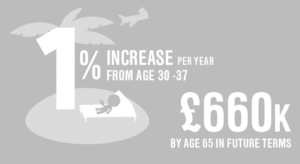Women and pensions: WASPIs and wives
It’s not an exaggeration to say that women seem to get a bit of a rough deal when it comes to pensions.
As a woman I could be accused of bias here, but really, the stats don’t lie and the truth is that there is a huge percentage of women heading towards poverty in later life.
Of course, there are thousands of men inadequately prepared for their retirement too, but there are factors specific to women that make them more likely to be facing meagre pensions when they come to retire.
WASPIs
There are factors specific to women that make them more likely to be facing meagre pensions when they come to retire.
For women born in the 1950s, the outlook is overshadowed by the dramatic increase in State Pension Age (SPA) to ‘equalise’ the historic gender gap. This is something that the Women Against State Pension Inequality (WASPI) have been tirelessly campaigning against – not that they disagree with equalisation, but in the way it has been communicated and how quickly, leaving these women little opportunity to make alternative plans for their retirement.
Wives
To add further hardship, those women who took advantage of paying reduced National Insurance contributions (NICs) between 1948 and 1977 can no longer claim a State Pension based on their husband’s NI record, since the introduction of the new State Pension last year. This is sometimes referred to as the ‘Married woman’s stamp’ which ensured that a married woman could rely on their husband’s NI record if she had taken time out of employment to raise a family and hadn’t built up enough NI contributions of her own.
Mothers
Historically the role of looking after the children has fallen to women, but even with a shift from the more traditional ideas of women staying home to raise the family, the impact on women’s finances and their ability to adequately provide for their own long-term financial security, is clear.
Even though Mums will still get their NI credits for the time they are at home (as long as they are registered for Child Benefit and their youngest child is under 12), women often struggle to accrue enough NICs and are prone to gaps in their NI record which can have an impact on the amount of State Pension they will receive. They may also often start saving into an employer provided pension much later in their lives, coming back to a career after their children leave home, or work part-time during those years with little or no available money to save into a pension for themselves.
Couple this with the fact that on average, women live longer than men resulting in spending longer in retirement and in receiving the state pension, and the picture is worryingly austere.
The gender debate
Our Generation WHY? research looks at how engaged everyday people are with their long-term savings and highlights that there is still a distinct disparity in retirement income expectations between men and women. Only 7% of the women surveyed expected to have a pot of between £500,000 and £1 million when they come to retire in comparison to 17% of men, and it’s possible that the gender pay gap has a part to play in forming these expectations.
The questions of equality and poverty are not new ones. But there does need to be wider debate, education and action sooner rather than later to avoid whole swathes of women falling into needless poverty in their old age.
“Redress the unfairness, for so called equality in retirement age pension. Women have been paid far less than men for years, so it’s hardly ‘equal’ to increase the State Pension Age for women to the same as men, when they’ve often earned more over their lifetime than women.”
Damian Stancombe, Partner and Head of Workplace Health and Wealth











